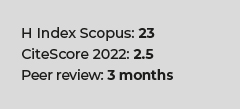Kaposi’s sarcoma in people living with HIV/AIDS in a public referral hospital in Peru
DOI:
https://doi.org/10.17843/rpmesp.2022.393.10883Keywords:
Kaposi’s Sarcoma, HIV, AIDS, Latin AmericaAbstract
Kaposi’s sarcoma (KS) is the most frequent cancer in people living with HIV. Research on this condition is scarce in the region, therefore, this article aimed to describe the demographic, clinical and therapeutic characteristics of patients with HIV who developed KS at the Cayetano Heredia Hospital between 2000 and 2018. A total of 129 KS cases were identified, with a median age of 33 years, predominantly males with 92% (119/129), and mostly men who have sex with men (MSM). The median time from HIV diagnosis to KS diagnosis was five months, associated with a CD4 lymphocyte count of 64 cells/μL (IQR: 33-185) at KS diagnosis. Cutaneous involvement was the most common presentation; however, at least half also had the visceral form.
Downloads
References
Semango GP, Charles RM, Swai CI, Mremi A, Amsi P, Sonda T, et al. Prevalence and associated risk factors for Kaposi’s sarcoma among HIV-positive patients in a referral hospital in Northern Tanzania: a retrospective hospital-based study. BMC Cancer. 2018;18(1):1258. doi: 10.1186/s12885-018-5155-2.
Cesarman E, Damania B, Krown SE, Martin J, Bower M, Whitby D. Kaposi sarcoma. Nat Rev Dis Primers. 2019;5(1):9. doi: 10.1038/s41572-019-0060-9.
Fink VI, Shepherd BE, Cesar C, Krolewiecki A, Wehbe F, Cortés CP, et al. Cancer in HIV-infected persons from the Caribbean, Central and South America. J Acquir Immune Defic Syndr. 2011;56(5):467–473. doi: 10.1097/QAI.0b013e31820bb1c3.
AIDS-defining Cancer Project Working Group for IeDEA and COHERE in EuroCoord. Comparison of Kaposi Sarcoma Risk in Human Immunodeficiency Virus-Positive Adults Across 5 Continents: A Multiregional Multicohort Study. Clin Infect Dis. 2017;65(8):1316–1326. doi: 10.1093/cid/cix480.
Amerson E, Woodruff CM, Forrestel A, Wenger M, McCalmont T, LeBoit P, et al. Accuracy of Clinical Suspicion and Pathologic Diagnosis of Kaposi Sarcoma in East Africa. J Acquir Immune Defic Syndr. 2016;71(3):295–301. doi: 10.1097/QAI.0000000000000862.
Mohanna S, Maco V, Bravo F, Gotuzzo E. Epidemiology and clinical characteristics of classic Kaposi’s sarcoma, seroprevalence, and variants of human herpesvirus 8 in South America: a critical review of an old disease. Int J Infect Dis. 2005;9:239–50. doi: 10.1016/j.ijid.2005.02.004.
Martro E, Esteve A, Schulz TF, Sheldon J, Gambús G, Muñoz R. Risk factors for human Herpesvirus 8 infection and AIDS-associated Kaposi’s sarcoma among men who have sex with men in a European multicentre study. Int J Cancer. 2007;120:1129–1135. doi: 10.1002/ijc.22281.
Mohanna S, Echaíz J, Ferrufino JC, Bravo F, Gotuzzo E. Perfil clínico y epidemiológico del sarcoma de Kaposi clásico y epidémico: estudio retrospectivo en el Hospital Nacional Cayetano Heredia. Folia dermatol. Peru 2006; 17 (3): 111-117. (10)
Tanaka LF, Latorre MDRD, Gutierrez EB, Christian Heumann C, Herbinger K-H, Froeschl G. Trends in the incidence of AIDS-defining and non-AIDS-defining cancers in people living with AIDS: a population-based study from São Paulo, Brazil. Int J STD AIDS. 2017;28(12):1190-1198. doi: 10.1177/0956462417692924.
Germán Ramírez-Olivencia, María Eulalia Valencia-Ortega, Luz Martin-Carbonero, Moreno-Celda V, González-Lahoz J. Tumores en pacientes con infección por el virus de la inmunodeficiencia humana: estudio de 139 casos. Med Clin(Barc). 2009;133(19):729–735. doi: 10.1016/j.medcli.2009.03.043.
Guanira JV, Casper C, Lama JR, Morrow R, Montano SM, Caballero P, et al. Prevalence and correlates of human herpesvirus 8 infection among Peruvian men who have sex with men. J Acquir Immune Defic Syndr. 2008;49(5):557–562. doi: 10.1097/QAI.0b013e31818d5bf8.
Crum-Cianflone NF, Hullsiek KH, Ganesan A, Weintrob A, Okulicz JF, Agan BK. Is Kaposi’s sarcoma occurring at higher CD4 cell counts over the course of the HIV epidemic?. AIDS. 2010; 24(18):2881-2883. doi: 10.1097/QAD.0b013e32833f9fb8.
Daly ML, Fogo A, McDonald C, Morris-Jones R. Kaposi sarcoma: no longer an AIDS-defining illness? A retrospective study of Kaposi sarcoma cases with CD4 counts above 300/mm³ at presentation. Clin Exp Dermatol. 2014;39(1):7-12. doi: 10.1111/ced.12163.
Maurer T, Ponte M, Leslie K. HIV-associated Kaposi’s sarcoma with a high CD4 count and a low viral load. N Engl J Med. 2007; 357(13):1352–1353. doi: 10.1056/NEJMc070508.
Mani D, Neil N, Israel R, Aboulafia DM. A retrospective analysis of AIDS-associated Kaposi’s sarcoma in patients with undetectable HIV viral loads and CD4 counts greater than 300 cells/mm(3). J Int Assoc Physicians AIDS Care (Chic Ill). 2009; 8(5):279–285. doi: 10.1177/1545109709341852.
Unemori P, Leslie KS, Hunt PW, Sinclair E, Epling L, Mitsuyasu R, et al. Immunosenescence is associated with presence of Kaposi’s sarcoma in antiretroviral treated HIV infection. AIDS. 2013;27(11):1735–1742. doi: 10.1097/QAD.0b013e3283601144.
Downloads
Published
Issue
Section
License
Copyright (c) 2022 Revista Peruana de Medicina Experimental y Salud Pública

This work is licensed under a Creative Commons Attribution 4.0 International License.


























